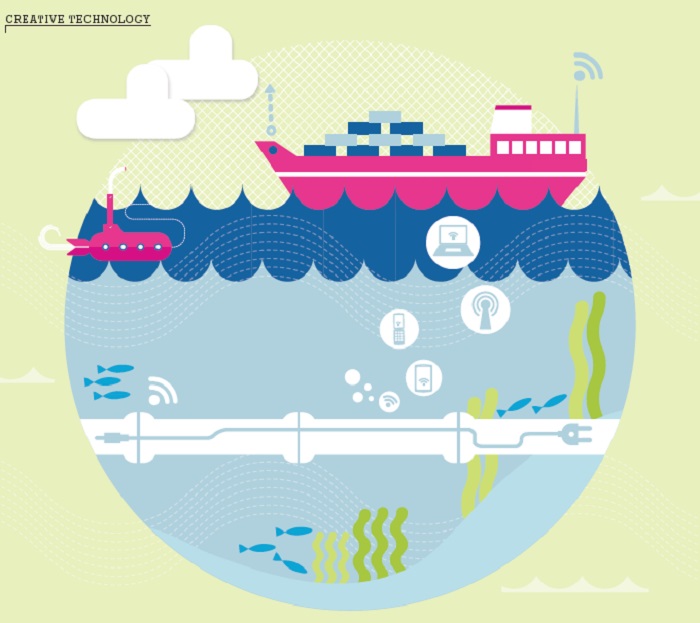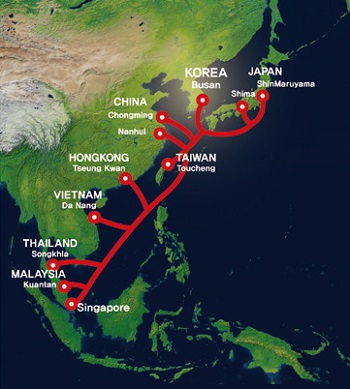View this article in another language
- 한국어
- English
- 日本語
- 中文
- العربية
- Español
- Français
- Deutsch
- Pусский
- Tiếng Việt
- Indonesian
In what will be remembered as a trailblazing project to use submarine cables to manage superfast cross-border Internet traffic, KT, the nation’s leading integrated wired and wireless telecommunications service provider, will soon also operate the world’s largest international submarine communications network from the southern port city of Busan.
On Oct. 21 this year – the second day of the 2014 World IT Show (WIS) – KT (formerly Korea Telecom) celebrated the opening of its Asia Pacific Gateway Network Operations Center (APG NOC), an integrated control center for the submarine communications network. The APG NOC will take on the role of being an APG control tower, managing the establishment, operation and risk management of the submarine cable network from the KT Busan International Center.

Cables without borders
When fully established, the submarine optical cable network will extend a total of 11,000 kilometers – with 6,000 meters laid underwater – and connect Korea with eight other Asian territories: China, Japan, Taiwan, Hong Kong, Vietnam, Thailand, Malaysia and Singapore. The APG is scheduled to be completed in 2015.
At the opening ceremony for the center, KT Chairman Hwang Chang-gyu said, “Through the effective management of the state-of-the-art integrated international submarine communications network, we are fully determined to promote South Korea’s position from being a communications hub for Northeast Asia to being a global hub for ICT (Information Communications Technology).”
Hwang’s remarks were echoed by Minister of Science, ICT and Future Planning Choi Yang-hee, who congratulated the nation’s leading mobile telecom carrier for taking charge of an international submarine communications network, saying, “I hope KT will advance beyond the walls of Asia to the United States and the European nations.”
KT established and leads the consortium of 13 companies – 10 overseas communications carriers and three investors, including Facebook – that decided to participate in the project for the APG’s implementation.
The data transmission speed of the APG is 40 Gbps (gigabytes per second) per wavelength, more than two times faster than existing submarine cables. The network has a transmission capacity of 38.4 Tbps (terabytes per second), the largest of around 280 underwater cables across the world, according to KT officials.
“Having been recognized for its technological expertise at stably operating six submarine cables, last year KT was able to obtain ISO 22301 certification, a standard course of action for such networks,” said Oh Seong-mok, director of KT’s Network Division, to Yonhap News.
 Exercising control
Exercising control
Analysts say that this project will help Korea to both control and initiate support for an international submarine communications network, as users in the nine countries will be able to exchange massive amounts of content at a much faster speed. They argue that it will also help promote the overseas advancement of domestic Internet service industries, while expanding the distribution of Korean mass media overseas.
In addition, KT predicts that the operation of the APG NOC will help attract Internet data centers and the R&D branches of global ICT businesses to Korea.
KT forecasts that it will likely receive more than KRW 1.1 billion annually from the APG consortium. Sales will eventually reach KRW 11.5 billion per year for maintenance services through the operation of the APG NOC.
Management of the integrated international submarine communications network is meaningful because KT has a preferential right in network control, meaning it retains a certain amount of leadership in the network, experts say. Meanwhile, KT has also formulated a plan to make its submarine communications network enter the Pacific region. The same day, KT signed an agreement with a global common carrier for the construction of a 14,000 km submarine cable, the New Cross Pacific (NCP) to directly connect Korea, China, Japan and Taiwan. The NCP will be opened and commercialized by the end of 2017.
* Article from Korea Magazine (December 2014)
On Oct. 21 this year – the second day of the 2014 World IT Show (WIS) – KT (formerly Korea Telecom) celebrated the opening of its Asia Pacific Gateway Network Operations Center (APG NOC), an integrated control center for the submarine communications network. The APG NOC will take on the role of being an APG control tower, managing the establishment, operation and risk management of the submarine cable network from the KT Busan International Center.

Cables without borders
When fully established, the submarine optical cable network will extend a total of 11,000 kilometers – with 6,000 meters laid underwater – and connect Korea with eight other Asian territories: China, Japan, Taiwan, Hong Kong, Vietnam, Thailand, Malaysia and Singapore. The APG is scheduled to be completed in 2015.
At the opening ceremony for the center, KT Chairman Hwang Chang-gyu said, “Through the effective management of the state-of-the-art integrated international submarine communications network, we are fully determined to promote South Korea’s position from being a communications hub for Northeast Asia to being a global hub for ICT (Information Communications Technology).”
Hwang’s remarks were echoed by Minister of Science, ICT and Future Planning Choi Yang-hee, who congratulated the nation’s leading mobile telecom carrier for taking charge of an international submarine communications network, saying, “I hope KT will advance beyond the walls of Asia to the United States and the European nations.”
KT established and leads the consortium of 13 companies – 10 overseas communications carriers and three investors, including Facebook – that decided to participate in the project for the APG’s implementation.
The data transmission speed of the APG is 40 Gbps (gigabytes per second) per wavelength, more than two times faster than existing submarine cables. The network has a transmission capacity of 38.4 Tbps (terabytes per second), the largest of around 280 underwater cables across the world, according to KT officials.
“Having been recognized for its technological expertise at stably operating six submarine cables, last year KT was able to obtain ISO 22301 certification, a standard course of action for such networks,” said Oh Seong-mok, director of KT’s Network Division, to Yonhap News.

KT’s submarine optical cable network will connect nine Asian territories. © KT
Analysts say that this project will help Korea to both control and initiate support for an international submarine communications network, as users in the nine countries will be able to exchange massive amounts of content at a much faster speed. They argue that it will also help promote the overseas advancement of domestic Internet service industries, while expanding the distribution of Korean mass media overseas.
In addition, KT predicts that the operation of the APG NOC will help attract Internet data centers and the R&D branches of global ICT businesses to Korea.
KT forecasts that it will likely receive more than KRW 1.1 billion annually from the APG consortium. Sales will eventually reach KRW 11.5 billion per year for maintenance services through the operation of the APG NOC.
Management of the integrated international submarine communications network is meaningful because KT has a preferential right in network control, meaning it retains a certain amount of leadership in the network, experts say. Meanwhile, KT has also formulated a plan to make its submarine communications network enter the Pacific region. The same day, KT signed an agreement with a global common carrier for the construction of a 14,000 km submarine cable, the New Cross Pacific (NCP) to directly connect Korea, China, Japan and Taiwan. The NCP will be opened and commercialized by the end of 2017.
* Article from Korea Magazine (December 2014)